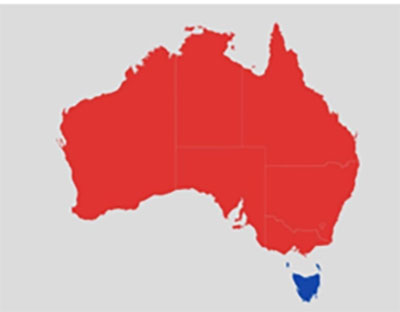Life on the West Island - A sunburnt country

29 March 2023
After last Saturday’s election in the Premier State, there has been much talk in West Island media and political circles that the nation has turned red – that is, the Labor Party is now in power in every mainland state and territory, with the Liberals reduced to a single government in Tasmania. This situation looks likely to continue for at least 18 months, because the next scheduled election is in Queensland, not due until October 2024. The Liberals might take some small comfort in holding a one-seat majority in the Apple Isle, where the next election is two years off and where by-elections are not held in the lower house due to use of a proportional representation electoral system.
Closer consideration of the apparent national supremacy of Labor shows that in fact its vote has mostly fallen across the board, but it is far outperforming the coalition, and in particular the Liberal Party, which has seen a catastrophic collapse in voter support in the past few years. Labor has won seven of the eight elections held since 2020, and holds majorities in six of the mainland parliaments. The exceptions are in the Australian Capital Territory, which has a proportional representation system that practically guarantees that no single party can gain a majority, and now apparently in New South Wales.
In all but one of its successful election results, Labor has failed to get more than 41% of the first preference vote. The exception was the Western Australian election of 2021, where Labor won 60% of the first preference vote and reduced the Liberals to just two seats in the 59-seat lower house. Its two next best results were in Queensland and South Australia, where it scraped up just over 40% of first preferences. Federally, it governs with a majority in the House of Representatives, despite collecting only 33% of the first preference vote. But the problem for the Liberals is that they attracted just under 24%, nowhere near enough to hope to form government.
Commentators are now beginning to ask whether the Liberal Party is in terminal decline, having lost huge chunks of its traditional support amongst women, and seeing younger voters turn toward progressive parties and independents. It is increasingly viewed by the electorate as a party of, and for, older white males. The bizarre and ongoing factional fights over preselections in federal and state seats seem to reinforce this perspective.
But there are other factors which could be driving the Liberal Party toward electoral oblivion, illustrated by the hysterical analysis of ultra-conservatives that the party lost the NSW election because it had abandoned its “base” and become too progressive by embracing some limited policies to transition to renewable energy. A more rational and likely analysis is that the party is increasingly seen by voters as being out of touch with big issues about which they are concerned, including growing inequality, rising costs of living, homelessness and climate change.
Economic journalist Michael Pascoe ties the loss of Liberal support to the insidious influence of the Murdoch media:
The Murdochs’ local business model increasingly is that of its American Fox News organ, playing to a conservative audience and in the process pushing its political arm further to the right. But unlike the US, thankfully, Australia enjoys compulsory attendance at polling booths, preferential voting and a degree of healthy scepticism – a combination that anchors election-winning politics closer to the centre than either extreme. The result has seen the Murdochs and fellow travellers pushing the Liberal Party to become more conservative, more disconnected from the centre and especially from women and the younger generation of voters (i.e. those under 50) – and thus out of government everywhere on the big island.
Prominent lawyer, commentator and human rights advocate Nyadol Nyuon added to this argument in a detailed and thoughtful piece in The Saturday Paper:
News Corp has been characterised as the party’s media wing or as a house organ. While this is true, I think it under-estimates the real scope of influence. News Corp has captured the Liberal Party. It is shifting the party away from being a political organisation and remaking it in the image of its ideological and corporate interests. Put differently, News Corp has done to the Liberals what it has done to journalism. In my view, the nature of the relationship between News Corp and the Liberals has made the Liberals incapable, to a larger extent than other political parties, of acting like a normal political organisation. That is because the Liberals have undue dependence on News Corp.
A similar view is held by some Liberal insiders. Imre Salusinszky, conservative writer and former media director for Mike Baird when he was NSW’s Liberal premier, was blunt when writing about the right-wing media influence:
As a premier or prime minister, you can give them what they want, but this buys only short-term relief. While their influence on the electorate is overstated, their influence in coalition party rooms, state and federally, is palpable. This is little surprise, given their willingness to harangue and bully coalition ministers and backbenchers.
Michael Pascoe believes that the ultra-conservative media “monster” created by the Murdoch empire has now institutionalised a situation where its audience expects to be fed ever more preposterous right-wing conspiracy theories, and so the media giant is locked in a trap of its own making. Dragging the Liberal Party into this maelstrom could bring its ultimate demise as a major party and make it unelectable.
All of this leads to West Island politics now being painted a sunburnt red, due more to the disintegration of the Liberal Party than a nationwide rise of Labor. Sunburn can be painful, and a healthy democracy requires effective political opposition and debate. Who will step in to fill the current vacuum?